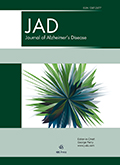Authors: Frank, Brandon | Walsh, Michael | Hurley, Landon | Groh, Jenna | Blennow, Kaj | Zetterberg, Henrik | Tripodis, Yorghos | Budson, Andrew E. | O’Connor, Maureen K. | Martin, Brett | Weller, Jason | McKee, Ann | Qiu, Wendy | Stein, Thor D. | Stern, Robert A. | Mez, Jesse | Henson, Rachel | Long, Justin | Aschenbrenner, Andrew J. | Babulal, Ganesh M. | Morris, John C. | Schindler, Suzanne | Alosco, Michael L.
Article Type:
Research Article
Abstract:
Background: Neuropsychiatric symptoms (NPS) can be an early manifestation of Alzheimer’s disease (AD). However, the associations among NPS, cognition, and AD biomarkers across the disease spectrum are unclear. Objective: We analyzed cross-sectional mediation pathways between cerebrospinal fluid (CSF) biomarkers of AD (Aβ1-42 , p-tau181 ), cognitive function, and NPS. Methods: Primary models included 781 participants from the National Alzheimer’s Coordinating Center (NACC) data set who had CSF analyzed for AD biomarkers using Lumipulse. NPS were assessed with the Neuropsychiatric Inventory Questionnaire (NPI-Q). We assessed cognition with the harmonized MMSE/MoCA, as well as neuropsychological tests sensitive to
…AD pathology: story recall, naming, animal fluency, and Trails B. The Clinical Dementia Rating (CDR® ) scale assessed dementia severity. Mediation models were estimated with Kemeny metric covariance in a structural equation model framework, controlling for age, education, sex, and APOE ɛ 4. Results: The sample was older adults (M = 73.85, SD = 6.68; 49.9% male, 390; 27.9% dementia, 218) who were predominantly white (n = 688, 88.1%). Higher p-tau181 /Aβ1-42 ratio predicted higher NPI-Q, which was partially mediated by the MMSE/MoCA and, in a second model, story recall. No other pathway was statistically significant. Both the MMSE/MoCA and NPI-Q independently mediated the association between p-tau181 /Aβ1-42 ratio and CDR global impairment. With dementia excluded, p-tau181 /Aβ1-42 ratio was no longer associated with the NPI-Q. Conclusions: NPS may be secondary to cognitive impairment and AD pathology through direct and indirect pathways. NPS independently predict dementia severity in AD. However, AD pathology likely plays less of a role in NPS in samples without dementia.
Show more
Keywords: Alzheimer’s disease, amyloid, biomarkers, cerebrospinal fluid, cognition, neuropsychiatric symptoms, p-tau
DOI: 10.3233/JAD-240125
Citation: Journal of Alzheimer's Disease,
vol. 100, no. 3, pp. 1055-1073, 2024
Price: EUR 27.50





